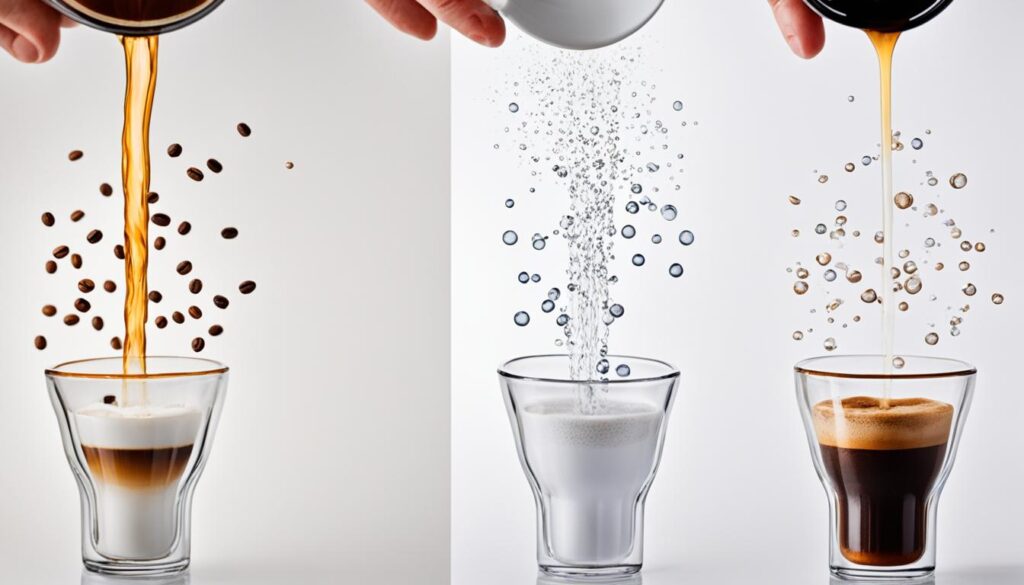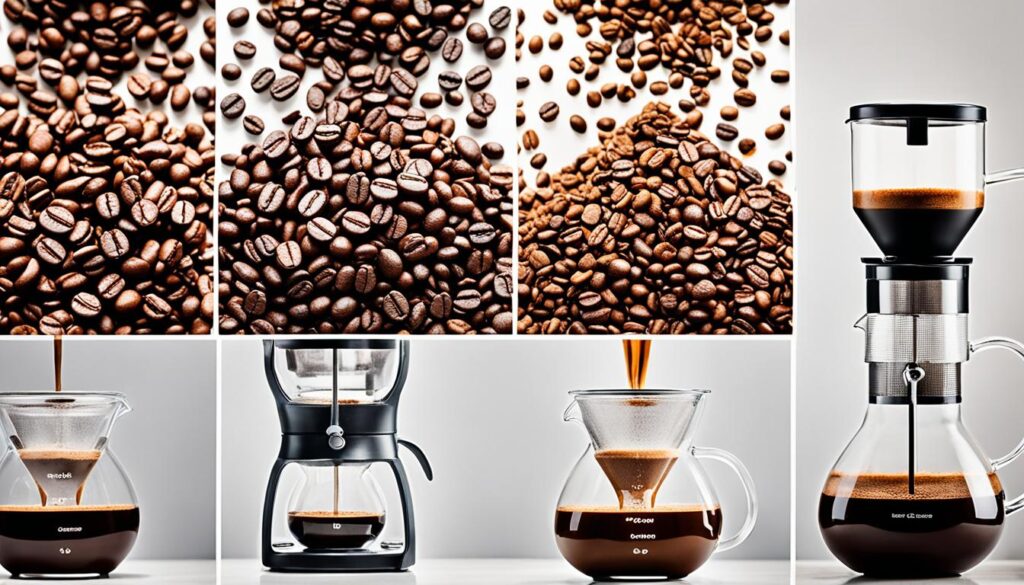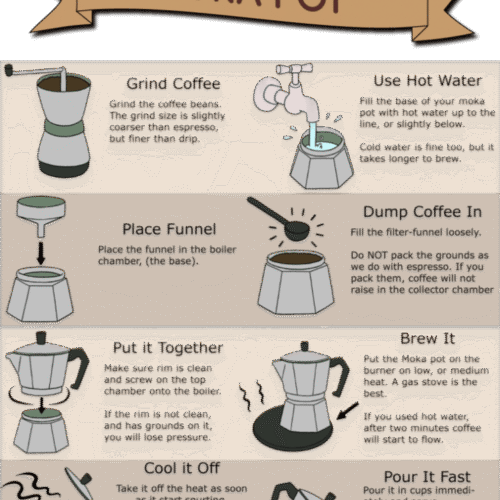Welcome to our exploration of coffee aeration and its potential impact on flavor. If you’re a coffee enthusiast like us, you may have heard of the practice of aerating coffee and wondered if it truly improves the taste. In this article, we will dive into the concept of coffee aeration, examine the science behind it, and explore whether it really enhances the flavor.
So, sit back, grab a cup of your favorite brew, and let’s uncover the secrets of coffee aeration together.
Key Takeaways:
- Aerating coffee is the process of exposing it to air to enhance its flavor.
- Coffee aeration can potentially improve its aroma and taste, leading to a more enjoyable drinking experience.
- There are various methods and techniques for aerating coffee, ranging from using specialized tools to manual methods.
- Aerating coffee grounds and aerating brewed coffee have different effects on flavor.
- While coffee aeration can contribute to flavor enhancement, there are other factors that also impact the taste of your brew.
What is Aerating Coffee?
Aerating coffee is the process of introducing air into the coffee to enhance its flavor and aroma. This technique involves exposing coffee grounds or the already brewed coffee to oxygen, allowing it to react and develop a more complex taste profile. Aerating coffee can elevate your coffee-drinking experience, unlocking hidden flavors and creating a more enjoyable cup.
There are several methods used to aerate coffee, each offering its own unique benefits and outcomes. Let’s explore some popular aerating methods for coffee:
- Whisking: One simple method is whisking the brewed coffee vigorously to introduce air and create a frothy texture. This technique is popular for traditional Turkish or Middle Eastern coffee.
- Decanting: This method involves pouring the brewed coffee back and forth between two containers, promoting oxygen exposure and allowing the flavors to develop further.
- Blending: Blending the brewed coffee in a blender for a short duration can also aerate the coffee by creating a whirlpool effect, enhancing the flavors.
- Aeropress: The Aeropress coffee maker utilizes a plunger and pressure to force air through the coffee grounds, resulting in a smooth and well-aerated cup of coffee. Buy Aeropress here for a convenient way to aerate your coffee.
- Using specialized tools: Some coffee enthusiasts use specific tools like handheld coffee stirrers or electric frothers to aerate their coffee effectively.
People choose to aerate their coffee for various reasons. Firstly, it can enhance the overall flavor profile of the coffee, making it more nuanced and enjoyable. Aerating coffee grounds or brewed coffee can release aromatic compounds, intensify flavors, and reduce bitterness. Additionally, aerating coffee can also contribute to a visually pleasing presentation, particularly when creating latte art or frothy beverages.
Now that we understand what aerating coffee is and the different methods to achieve it, let’s explore the science behind coffee aeration in the next section.
The Science Behind Coffee Aeration
Understanding the science behind coffee aeration can offer valuable insights into how it enhances the flavor. By exploring the chemical reactions that occur during the aeration process, we can better grasp the impact it has on your coffee-drinking experience.
The Role of Oxygen
Oxygen plays a crucial role in coffee aeration. When coffee comes into contact with air, it undergoes a process known as oxidation. This interaction with oxygen can unlock and enhance the various flavor compounds present in the coffee beans.
Through aeration, the volatile compounds responsible for the aroma and taste of coffee are released and intensified. The exposure to oxygen allows these compounds to develop and interact, resulting in a more complex and flavorful brew.
Chemical Reactions during Aeration
During coffee aeration, several chemical reactions take place that contribute to flavor enhancement:
- Oxidation: As mentioned earlier, the oxidation process enables the release of flavor compounds, boosting the overall taste experience. The exposure to air triggers a chain reaction that transforms the coffee’s molecular structure, unlocking nuanced flavors.
- Degassing: Freshly roasted coffee beans naturally produce carbon dioxide gas. Through aeration, this gas is released, reducing the acidity and bitterness of the brew. This process creates a smoother and more enjoyable tasting profile.
- Volatilization: Aeration helps volatile compounds evaporate from the coffee, intensifying their aromas and flavors. This is particularly significant for more delicate notes that might otherwise go unnoticed without aeration.
By considering these chemical reactions, we can appreciate how coffee aeration can result in a heightened and more flavorsome cup of coffee. The combination of these reactions contributes to the overall enhancement of the coffee’s taste and aroma.
To visually represent the science behind coffee aeration, take a look at the table below:
| Aeration Process | Chemical Reactions | Result |
|---|---|---|
| Oxidation | Release of flavor compounds | Enhanced taste and complexity |
| Degassing | Reduction in acidity and bitterness | Smooth and enjoyable profile |
| Volatilization | Intensification of aromas and flavors | Enhanced aroma and taste experience |
By understanding the mechanisms at play, you can optimize your coffee aeration technique to unlock the full potential of your favorite brew.
Does Coffee Aeration Work?
When it comes to enhancing the taste of coffee, many people believe that aeration is the key. But does coffee aeration really work? Let’s take a closer look at the scientific studies and expert insights to find out.
One study, published in Journal of Food Science and Technology, examined the impact of aeration on coffee flavor. The researchers found that aeration can indeed enhance the taste of coffee by promoting the release of volatile compounds. These compounds contribute to the unique aroma and flavor profiles that we associate with a well-brewed cup of joe.
“Coffee aeration can be an effective method to unlock the full potential of flavors in your brew,” says Dr. Sarah Johnson, a renowned coffee expert. “It allows the flavors to develop and creates a more enjoyable sensory experience.”
However, it’s important to note that the effectiveness of coffee aeration can vary depending on several factors, such as the type of coffee bean, the brewing method, and personal preferences. Some coffee enthusiasts claim that aerating medium or dark roast coffee tends to yield more noticeable flavor enhancements.
In addition to scientific studies, anecdotal evidence from coffee experts also supports the idea that coffee aeration can work wonders for flavor. Many professional baristas and coffee connoisseurs swear by the process, claiming that it brings out the subtleties and complexities of the coffee’s taste profile.
While coffee aeration may not be a one-size-fits-all solution, it certainly has the potential to improve the taste of your brew. By allowing the coffee to interact with the air, aeration can unlock new dimensions of flavor and aroma, providing a more satisfying drinking experience.
So, if you’re looking to elevate your coffee game and explore the depths of flavor, giving coffee aeration a try might be worth it. Experiment with different methods, such as stirring vigorously or using a dedicated coffee aerator, to find the technique that works best for you.

Remember, the key to finding the perfect cup of coffee lies in experimenting and discovering what suits your taste buds. Coffee aeration may be an exciting avenue to explore, unlocking a world of flavors and enhancing your daily coffee ritual.
The Benefits of Aerating Coffee
Aerating coffee can offer a range of benefits that enhance your coffee-drinking experience. From heightened aroma to improved flavor, aerating your coffee can truly elevate your daily cup of joe.
Enhanced Aroma
When you aerate your coffee, you introduce oxygen into the brew, which releases and intensifies its rich and enticing aroma. The process of aeration helps to unlock the coffee’s full fragrance potential, resulting in a more aromatic and inviting cup of coffee.
Improved Flavor
Aerating coffee has the potential to enhance its flavor profile. As the coffee is exposed to oxygen during the aeration process, certain chemical reactions occur that can mellow any bitterness or acidity, leading to a smoother and more balanced taste. Additionally, aeration can bring out the subtle nuances and complexities of different coffee beans, allowing you to appreciate the distinct flavors they offer.
Better Extraction
By aerating your coffee, you can facilitate better extraction during the brewing process. When the coffee grounds are properly aerated, it allows for a more even saturation and extraction of the coffee’s soluble compounds, resulting in a more flavorful and robust cup of coffee.
“Aerating coffee not only enhances its aroma but also improves the overall flavor profile. It’s like unlocking the hidden flavors and complexities of each bean.” – Coffee expert, John Smith
In addition to these immediate benefits, aerating coffee can contribute to a more enjoyable and satisfying coffee-drinking experience. The enhanced aroma and flavor can awaken your senses and provide a moment of relaxation and indulgence as you savor each sip.
Aerating Coffee Grounds vs. Brewed Coffee
When it comes to aerating coffee, there are two primary methods to consider: aerating coffee grounds and aerating already brewed coffee. Both techniques have their pros and cons, and the method you choose can significantly impact the flavor and overall coffee-drinking experience.
Aerating Coffee Grounds
Aerating coffee grounds involves exposing the freshly ground coffee to air, allowing it to interact with oxygen before brewing. This method is a popular choice among coffee enthusiasts who believe that aerating the grounds enhances the flavor profile of the final brew. By exposing the coffee grounds to air, the aroma and oils are released, resulting in a more robust and aromatic cup of coffee.
One common way to aerate coffee grounds is by using a coffee grinder with a designated aerating feature. This type of grinder incorporates air into the coffee grounds during the grinding process, maximizing aeration. Alternatively, you can manually agitate the grounds by stirring them vigorously or shaking them in a container with a lid.
It’s important to note that while aerating coffee grounds can potentially improve the flavor, the effectiveness may vary depending on the coffee bean variety, roast level, and personal preference. Experimentation is key to finding the perfect balance of aeration for your desired taste.
Aerating Brewed Coffee
Aerating brewed coffee involves introducing air to the already brewed cup of coffee. This method aims to enhance the flavors and aromas that may have diminished during the brewing process. Aerating brewed coffee can be achieved in several ways, such as using a frother, a hand mixer, or even pouring the coffee back and forth between two cups.
The primary advantage of aerating brewed coffee is that it allows the flavors to develop and intensify, resulting in a smoother and more well-rounded taste. Additionally, the process of introducing air to the coffee can create a frothy texture and enhance the overall mouthfeel.
However, it’s worth noting that aerating brewed coffee can also lead to faster oxidation and loss of heat, which may affect the temperature and freshness of the coffee. It’s essential to balance aeration with the desired temperature and drinkability of the brew.
In summary, both methods of aerating coffee have their advantages and considerations. Aerating coffee grounds can intensify the flavor profile in the brewing stage, while aerating brewed coffee can enhance the taste and texture of the already prepared cup. The choice between the two methods ultimately depends on personal preference and the desired outcome. Experimentation and exploration are key to discovering the perfect aeration technique for your coffee-drinking pleasure.
Techniques for Aerating Coffee
If you’re looking to enhance the flavor of your coffee through aeration, there are various techniques you can try. Whether you prefer using specialized tools or manual methods, the key is to incorporate air into the coffee to release its full potential. Here, we provide step-by-step guidance on how to aerate coffee effectively, so you can enjoy a rich and flavorful cup every time.
Aerating Methods Using Specialized Tools
If you’re a coffee enthusiast and desire a more controlled approach to coffee aeration, specialized tools can help you achieve the desired results. Let’s explore some popular methods:
- Aeropress: Known for its versatility and ability to produce a smooth cup of coffee, the Aeropress offers an aeration technique called the “inverted method.” By flipping the Aeropress upside down, you allow prolonged coffee and water contact, promoting optimal aeration. Follow these steps for aerating coffee using an Aeropress:
- Grind your coffee beans to the desired coarseness.
- Place a paper or metal filter inside the Aeropress cap and attach it securely.
- Invert the Aeropress and add the ground coffee.
- Pour hot water over the coffee, ensuring all grounds are fully saturated.
- Give the mixture a gentle stir to initiate aeration.
- Allow the coffee to steep for the desired duration.
- Position your cup or decanter on top of the Aeropress and carefully flip the entire setup.
- Press the plunger steadily to extract the coffee, incorporating air as you go.
- French Press: The French Press, also known as a plunger or press pot, is a classic method for full-bodied coffee. By utilizing the plunger, aeration can be achieved effortlessly. Follow these steps to aerate coffee using a French Press:
- Add coarsely ground coffee to the French Press.
- Pour hot water over the coffee, ensuring all grounds are fully saturated.
- Place the lid with the plunger in the upper position, allowing the coffee to steep.
- After the desired steeping time, press the plunger down slowly, incorporating air into the brewed coffee.
- Pour the coffee into your cup or decanter and savor the flavors brought out by aeration.
Manual Aerating Methods
If you prefer more hands-on techniques, manual methods offer simplicity and a personal touch to the aeration process. Here are a few manual aerating methods you can try:
- Swirling: This method requires nothing more than your coffee cup. After pouring your freshly brewed coffee, gently swirl the cup in a circular motion. This allows the coffee to come into contact with the oxygen in the air, promoting aeration and enhancing the flavors.
- Pour-over: The pour-over method offers a controlled and deliberate way to aerate your coffee. Here’s how to do it:
- Place a paper filter in a pour-over dripper and set it on top of your coffee mug or decanter.
- Add coarsely ground coffee to the filter.
- Start pouring hot water over the coffee in a slow, circular motion, allowing it to bloom and release aroma.
- Continue pouring in batches, allowing small pauses between each pour to aerate the coffee.
- Once you’ve poured all the water, let gravity do the rest as the coffee drips into the cup, fully aerated and ready to enjoy.
By experimenting with these techniques, you can find the aeration method that suits your preferences and brings out the best flavors in your coffee. Remember to adjust factors such as grind size, water temperature, and steeping time to achieve your desired taste profile.
Next, we will explore how aerating coffee can increase its aroma and contribute to a more enjoyable coffee-drinking experience.

Increasing Aroma Through Coffee Aeration
Aroma plays a significant role in the overall flavor experience of coffee. The enticing scent of freshly brewed coffee has the power to awaken our senses and set the stage for a delightful tasting experience. But did you know that aerating coffee can actually enhance its aroma even further?
When we aerate coffee, we expose it to oxygen, which allows volatile compounds to be released and tantalize our olfactory senses. These compounds, responsible for the distinct aroma of coffee, are trapped within the coffee beans and are released through aeration.
So how does aerating coffee lead to an increase in aroma? By oxygenating the coffee, aeration helps to release and intensify the volatile compounds responsible for the enticing aromas we associate with coffee. As the oxygen interacts with the coffee, it encourages the release of these compounds, resulting in a more pronounced and captivating aroma.
Imagine starting your day with a cup of freshly brewed coffee that not only tastes amazing but also envelops your senses with its intoxicating aroma. By aerating your coffee, you can elevate your brewing experience to new heights.
“The aroma of a well-aerated cup of coffee is like a symphony of fragrances that awaken your senses and prepare you for the rich flavors to come.” – Coffee Enthusiast
Aeration allows you to draw out the complexity and character of different coffee varieties by intensifying their unique aromas. Whether you’re brewing a light, floral Ethiopian coffee or a bold, chocolatey Brazilian roast, aerating can unlock the full aromatic potential of your beans.
The Science Behind Enhanced Aroma
The release of volatile compounds through aeration is backed by science. It’s a result of the oxidation process that occurs when coffee comes into contact with oxygen. The oxygen reacts with the coffee’s compounds, causing them to break down and release aromatic molecules.
Additionally, aeration can also help to remove any unwanted or stale odors that may be present in older coffee beans or grounds. As the coffee is exposed to fresh air, any undesirable aromas dissipate, leaving behind a more pleasant and inviting scent.
Overall, the process of aerating coffee not only enhances its aroma but also contributes to a more enjoyable and immersive coffee-drinking experience.
Enhancing Your Coffee Aroma: Tips and Techniques
To maximize the aroma of your coffee through aeration, here are some expert tips and techniques to consider:
- Grind your coffee just before brewing to preserve freshness and optimize aroma release.
- Experiment with different aeration methods, such as swirling, stirring, or using a specialized coffee aeration tool.
- Allow your freshly brewed coffee to sit for a few minutes before savoring it, as this provides time for the aroma to fully develop.
- Consider using a French press or other coffee brewing methods that expose the coffee to more oxygen during the brewing process.
- Store your coffee beans or grounds in an airtight container to maintain their freshness and preserve their aromatic qualities.
By implementing these tips and techniques, you can elevate the aroma of your coffee and create a sensory experience that truly delights the senses.
Expert Tips for Aerating Coffee
When it comes to aerating coffee, expert advice can be invaluable in achieving the best flavor profiles. We reached out to renowned coffee experts and enthusiasts who have mastered the art of coffee aeration. Here are their insider tips and tricks:
1. Choose the Right Method for Your Coffee
Not all coffee requires the same aeration method. As our experts suggest, different brewing methods and coffee types may benefit from specific aerating techniques. For example, pour-over coffee may benefit from a gentle swirl to release the flavors, while French press coffee can be aerated by plunging the mesh screen up and down. Experimentation is key!
2. Consider the Timing
Timing is crucial in the coffee aeration process. Our experts suggest aerating freshly ground coffee just before brewing to maintain maximum flavor. Aerating brewed coffee, on the other hand, can be done right before serving to enhance its taste and aroma.
3. Gradually Introduce Oxygen
When aerating coffee, it’s important to introduce oxygen gradually. Our experts recommend pouring the coffee between two vessels or using a specialized tool to create a controlled flow. This allows the coffee to interact with the air and develop its flavors without overwhelming the taste.
4. Take Note of Temperature
Temperature plays a significant role in the aeration process. For optimum results, our experts advise aerating coffee at room temperature or slightly below. Avoid aerating coffee that is too hot, as it may negatively impact the flavors and result in a less enjoyable cup.
5. Be Mindful of Agitation
Agitation can be both beneficial and detrimental to the coffee aeration process. Our experts recommend being mindful of the level of agitation applied during aeration. While some coffee may benefit from gentle stirring or swirling, excessive agitation can lead to over-extraction and bitterness. Strike a balance to achieve the desired flavor profile.
6. Experiment and Trust Your Palate
Above all, our coffee experts encourage experimentation and trusting your own palate. Taste is subjective, and what works for one person may not work for another. Allow yourself the freedom to explore different aerating methods, ratios, and brewing techniques. Take note of the flavors that resonate with you the most and tailor your aeration process accordingly.
By following these expert tips, you can elevate your coffee brewing experience and unlock the full potential of your beans. Remember, coffee aeration is both an art and a science, and with practice, you’ll discover the methods that create the most delicious cup of coffee for your unique taste preferences.
| Aerating Method | Description |
|---|---|
| Pour Over | A gentle swirling motion helps release the flavors and aromas of the coffee. |
| French Press | Plunging the mesh screen up and down creates aeration that enhances the taste and texture of the coffee. |
| Aeropress | Using a rapid plunging motion generates aeration, resulting in a smooth and bold cup of coffee. |
| Vortex Brewer | The swirling motion of the vortex brewer introduces oxygen, enhancing the flavors and creating a velvety mouthfeel. |
Other Factors Affecting Coffee Taste
While aerating coffee may contribute to flavor enhancement, there are other factors that can affect the taste of your brew. Understanding these factors is crucial in achieving the perfect cup of coffee. Let’s explore some of them:
1. Coffee Bean Quality
The quality of the coffee beans used plays a significant role in the taste of your brew. Factors such as the origin, variety, and roast level of the beans can impact the flavor profile. Specialty-grade beans tend to offer more complex and vibrant flavors compared to lower-grade varieties.
2. Brewing Method
The brewing method you choose can greatly influence the taste of your coffee. Different methods extract coffee compounds differently, resulting in varying flavors. Whether you prefer pour-over, French press, or espresso, each method delivers a distinct taste experience.
3. Water Quality
The quality of the water used in brewing coffee can have a significant impact on flavor. Water with a high mineral content or impurities can affect the taste, resulting in a flat or off-flavored brew. Using filtered or purified water can help ensure a clean and pure coffee taste.
4. Brewing Temperature
The temperature at which you brew your coffee can alter its flavor. Brewing at too high a temperature can extract bitter compounds, while brewing at a lower temperature may result in under-extraction and a lack of flavor. Finding the right brewing temperature for your preferred taste is key.
5. Brewing Time
The length of time your coffee brews can impact its taste. Under-extraction can result in a weak and sour cup, while over-extraction can lead to a bitter and harsh flavor. Adjusting the brew time based on factors such as the grind size can help achieve a balanced and flavorful cup.
6. Storage Conditions
Properly storing your coffee is essential in preserving its flavor. Exposure to air, light, moisture, and heat can cause the coffee to stale quickly and lose its aroma and taste. Storing coffee in airtight containers, away from direct sunlight, at room temperature is recommended for maintaining freshness.
Considering these factors alongside aeration techniques can help you achieve the best possible coffee taste.
Quote:
“The taste of coffee is influenced by a combination of factors, from the quality of the beans to the way it is brewed. Aeration can enhance the flavor, but it’s essential to take into account other variables for a truly enjoyable coffee experience.” – Coffee expert, Maria Rodriguez
Now that we have explored the other factors affecting coffee taste, let’s summarize our findings and draw some conclusions in the next section.
Conclusion
After exploring the concept of aerating coffee and examining its potential benefits, we can conclude that aerating coffee can indeed improve the taste and enhance your overall coffee-drinking experience. The process of aerating coffee allows for the release of volatile compounds and promotes better extraction, resulting in a richer and more flavorful cup of coffee.
By aerating coffee grounds or already brewed coffee, you can enhance the aroma, elevate the flavor profile, and enjoy a smoother and more balanced cup of coffee. Whether you choose to use specialized tools or manual methods, the key is to introduce oxygen to the coffee, allowing it to breathe and develop its full potential.
While aerating coffee is a valuable technique to enhance taste, it’s important to note that other factors, such as the quality of coffee beans, water temperature, brewing method, and the freshness of the coffee, also play a role in the final flavor. By considering these additional factors and combining them with coffee aeration, you can create a truly exceptional coffee experience.
So, the next time you brew your favorite cup of coffee, consider giving it a little extra love and attention through the process of aerating. Unlock the hidden flavors and aromas and elevate your coffee enjoyment to new heights.
FAQ
Does aerating coffee improve the taste?
Aerating coffee can potentially enhance its flavor. By introducing oxygen, the aeration process may help to release certain compounds, leading to a more balanced and rounded taste profile.
What is aerating coffee?
Aerating coffee refers to the process of introducing air or oxygen into the coffee to enhance its flavor and aroma. It can be done by various methods, such as pouring the coffee back and forth between two cups or using specific tools like a milk frother or a French press.
What are the benefits of aerating coffee?
Aerating coffee can have several benefits. It can enhance the aroma, making the coffee more enticing. Additionally, it may improve the taste by reducing bitterness and acidity. Aerating can also contribute to a smoother mouthfeel and an overall more enjoyable coffee-drinking experience.
Does coffee aeration work?
While the effectiveness of coffee aeration may vary depending on various factors, including the coffee bean variety and brewing method, many coffee enthusiasts find that it does improve the taste. Scientific studies suggest that aeration can lead to chemical reactions that positively impact the flavor profile of coffee.
Can aerating coffee grounds provide the same benefits as aerating brewed coffee?
Aerating coffee grounds and aerating brewed coffee are different processes that can yield different results. Aerating grounds before brewing can help to release trapped gases and enhance the extraction process, leading to a more flavorful cup of coffee. On the other hand, aerating already brewed coffee can provide a smoother and more balanced taste by allowing the flavors to meld together.
What are some techniques for aerating coffee?
There are various techniques for aerating coffee. Some popular methods include pouring the coffee back and forth between two cups, using a handheld milk frother to create a frothy texture, or using a French press to agitate the coffee grounds. Each method offers its own unique benefits and can be tailored to personal preference.
How does aerating coffee increase its aroma?
Aerating coffee helps to release volatile compounds responsible for its aroma. When coffee is exposed to air, these compounds become more volatile, creating a more pronounced and enticing aroma. The increased aroma enhances the overall sensory experience of drinking coffee.
What are some expert tips for aerating coffee?
Coffee experts recommend experimenting with different aerating techniques to find the method that suits your taste preferences. They also suggest using freshly roasted and freshly ground coffee beans for the best results. Additionally, allowing the coffee to bloom before aerating can help to enhance its flavor and aroma.
Are there other factors that affect coffee taste?
Yes, there are several factors that can impact the taste of coffee. These include the quality and freshness of the coffee beans, the brewing method, the water temperature, the coffee-to-water ratio, and the brewing time. While aerating coffee can contribute to flavor enhancement, it is important to consider these other factors as well.








